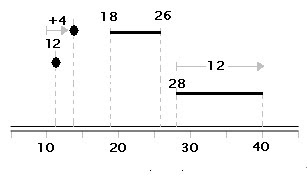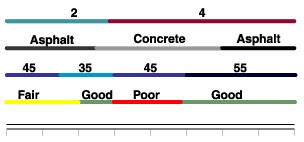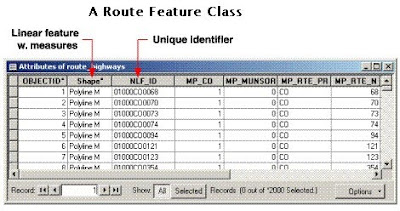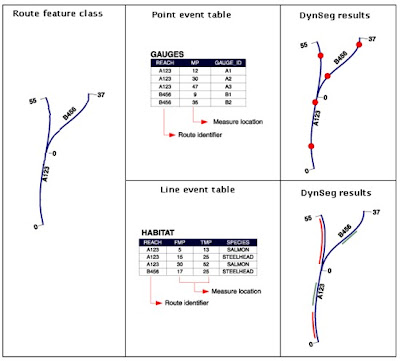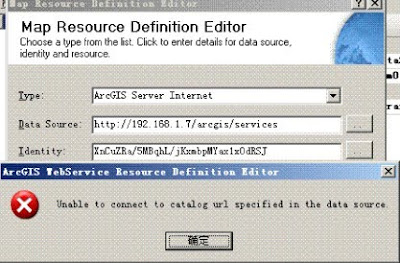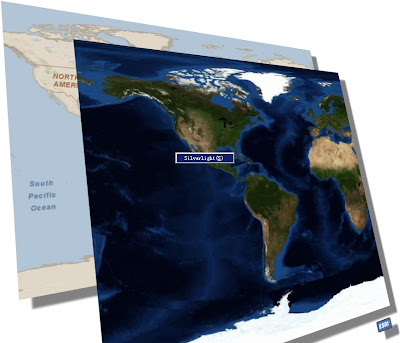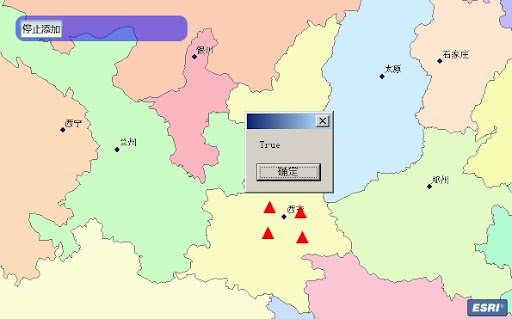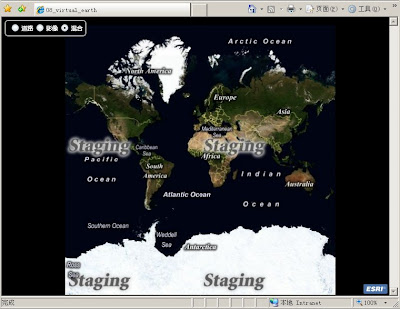现在来实现上面提到的3个功能。
1、对于某条公路上的一点进行Identify操作,要求返回该点在公路上的桩号值:
以Silverlight API为例。为了在服务器端使用ArcObjects,在Asp.net工程中添加一个名为LinearRef的Silverlight-Enabled WCF Service,在LinearRef.svc.cs文件中添加以下代码:
namespace RoadDycSeg.Web.WCF
{
[ServiceContract(Namespace = "")]
[AspNetCompatibilityRequirements(RequirementsMode = AspNetCompatibilityRequirementsMode.Allowed)]
public class LinearRef
{
public IRouteLocator2 pRtLocator = null;
ESRI.ArcGIS.Server.IServerObjectManager pSOM = null;
public ESRI.ArcGIS.Server.IServerContext pServerContext = null;
public LinearRef()
{
ESRI.ArcGIS.ADF.Identity identity = new ESRI.ArcGIS.ADF.Identity("ArcGISWebServices", "yourpassword", "");
ESRI.ArcGIS.ADF.Connection.AGS.AGSServerConnection agsconn = new ESRI.ArcGIS.ADF.Connection.AGS.AGSServerConnection("localhost", identity);
agsconn.Connect();
pSOM = agsconn.ServerObjectManager;
pServerContext = pSOM.CreateServerContext("shaanxi", "MapServer");
ESRI.ArcGIS.Carto.IMapServer2 pMapServer = pServerContext.ServerObject as ESRI.ArcGIS.Carto.IMapServer2;
ESRI.ArcGIS.Carto.IMapServerObjects2 pMapServerObjects = pMapServer as ESRI.ArcGIS.Carto.IMapServerObjects2;
ESRI.ArcGIS.Carto.IMap pMap = pMapServerObjects.get_Map(pMapServer.DefaultMapName);
IFeatureClass pFC = (pMap.get_Layer(2) as ESRI.ArcGIS.Carto.IFeatureLayer).FeatureClass;
//create the RouteLocator
IDataset dS = (IDataset)pFC; // A polylineM feature class.
IName name = dS.FullName;
IRouteLocatorName rtLocatorName = pServerContext.CreateObject("esriLocation.RouteMeasureLocatorName") as IRouteLocatorName;
rtLocatorName.RouteFeatureClassName = name;
rtLocatorName.RouteIDFieldName = "道路编码";
rtLocatorName.RouteMeasureUnit = esriUnits.esriUnknownUnits;
name = (IName)rtLocatorName;
pRtLocator = (IRouteLocator2)name.Open();
pServerContext.ReleaseContext();
}
// Add more operations here and mark them with [OperationContract]
[OperationContract]
///
///
/// the x coords of the mouseclick in map units /// the y coords of the mouseclick in map units /// the map distance of 1 pixel ///
public IdentifyResult Identify(double mapX, double mapY, double resolution)
{
pServerContext = pSOM.CreateServerContext("shaanxi", "MapServer");
IdentifyResult ir = new IdentifyResult("", -1, -1, -1);
IPoint pPoint = pServerContext.CreateObject("esriGeometry.Point") as IPoint;
pPoint.PutCoords(mapX, mapY);
IEnvelope pEnvelope = pPoint.Envelope;
pEnvelope.Expand(10 * resolution, 10 * resolution, false);
IEnumRouteIdentifyResult pEnumResult = pRtLocator.Identify(pEnvelope, "");
pEnumResult.Reset();
//only get the first result
if (pEnumResult.Count > 0)
{
IRouteLocation pRL = null;
IFeature pF = null;
pEnumResult.Next(out pRL, out pF);
IRouteMeasurePointLocation pRMPL = pRL as IRouteMeasurePointLocation;
//retrieve the location geometry by calling LOCATE method
IRouteLocation routeLocation = pServerContext.CreateObject("esriLocation.RouteMeasurePointLocation") as IRouteLocation;
routeLocation.MeasureUnit = esriUnits.esriUnknownUnits;
routeLocation.RouteID = pRL.RouteID;
routeLocation.LateralOffset = 0;
IRouteMeasurePointLocation rMPointLoc = (IRouteMeasurePointLocation)routeLocation;
rMPointLoc.Measure = pRMPL.Measure;
IGeometry geom;
esriLocatingError locError;
pRtLocator.Locate((IRouteLocation)rMPointLoc, out geom, out locError);
ir.RouteID = pRL.RouteID.ToString();
ir.MValue = pRMPL.Measure;
ir.X = (geom as IPointCollection5).get_Point(0).X;
ir.Y = (geom as IPointCollection5).get_Point(0).Y;
}
pServerContext.ReleaseContext();
return ir;
}
其中,IdentifyResult是自定义的一个类,用来存储查询的结果:namespace RoadDycSeg.Web.WCF
{
///
///
[DataContract]
public class IdentifyResult
{
[DataMember]
public string RouteID {get;set;}
[DataMember]
public double MValue {get;set;}
[DataMember]
public double X {get;set;}
[DataMember]
public double Y {get;set;}
public IdentifyResult(string routeid, double mvalue, double x, double y)
{
RouteID = routeid;
MValue = mvalue;
X = x;
Y = y;
}
}
}
Identify方法需要传入3个参数,一个点的地理坐标以及当前地图的Resolution,后者用来生成一个10像素的缓冲区,方便用户的点击操作;其中利用IRouteLocator2.Identify方法获得M值,据此利用 IRouteLocator2.Locate方法获得精确落在公路上的点的Geometry,用以显示在客户端;如果用户点击的点距离公路较远,则IRouteLocator2.Identify结果为空,返回的IdentifyResult中M值为-1。
在Silverlight工程中,Add Service Reference,找到刚才的LinearRef服务,取名为LRService。
客户端中,新建一个COperation类,实现业务操作。public class COperation
{
private LRService.LinearRefClient LR = null;
private GraphicsLayer glayer = null;
private bool isBusy = false;//indicate whether there is an operation is performing
private Map Map1 = null;
public COperation(Map map)
{
Map1=map;
glayer = Map1.Layers["glayer"] as GraphicsLayer;
//initialize the LR object
LR = new RoadDycSeg.LRService.LinearRefClient();
LR.IdentifyCompleted += new EventHandler
}
private void LR_IdentifyCompleted(object sender, LRService.IdentifyCompletedEventArgs e)
{
LRService.IdentifyResult ir = e.Result;
//add a point graphic to the map with attributes displaying by the maptip, maptip defined in mainpage.xaml
if (ir.X > 0)//the result exists
{
Graphic g = new Graphic()
{
Geometry = new MapPoint(ir.X, ir.Y),
Symbol = Application.Current.Resources["strobeSymbol"] as Symbol,
};
g.Attributes.Add("RouteID", ir.RouteID);
g.Attributes.Add("桩号", ir.MValue);
g.Attributes.Add("X坐标", ir.X);
g.Attributes.Add("Y坐标", ir.Y);
glayer.Graphics.Clear();
glayer.Graphics.Add(g);
}
isBusy = false;
}
private void Map1_Identify(object sender, ESRI.ArcGIS.Client.Map.MouseEventArgs e)
{
if (!isBusy)
{
LR.IdentifyAsync(e.MapPoint.X, e.MapPoint.Y, Map1.Resolution);
isBusy = true;
}
}
在需要使用Identify功能时,将Map控件的Click事件绑定到Map1_Identify即可。结果如图: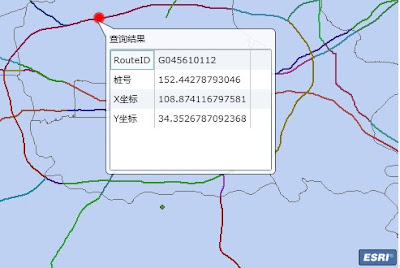
2、输入起始和终止桩号,要求将其间的路段显示在地图上:
要解决这个问题,关键是根据两个M值,求的其间一段公路的Geometry。利用的仍然是IRouteLocator2.Locate方法,其中的第一个参数routeLocation,传入的是用IRouteMeasureLineLocation接口定义的“线性位置”,具体可参考帮助文档。
仍然是在LinearRef.svc.cs文件的LinearRef类中,添加以下方法:[OperationContract(Name = "RetrieveRoutePortionGeometry")]
///
///
/// the route id which the portion is part of /// fromMvalue /// toMvalue ///
public string RetrieveRoutePortionGeometry(string routeid, double fromMValue, double toMValue)
{
pServerContext = pSOM.CreateServerContext("shaanxi", "MapServer");
IRouteLocation routeLoc = pServerContext.CreateObject("esriLocation.RouteMeasureLineLocation") as IRouteLocation;
routeLoc.MeasureUnit = esriUnits.esriUnknownUnits;
routeLoc.RouteID = routeid;
routeLoc.LateralOffset = 0;
IRouteMeasureLineLocation rMLineLoc = (IRouteMeasureLineLocation)routeLoc;
rMLineLoc.FromMeasure = fromMValue;
rMLineLoc.ToMeasure = toMValue;
IGeometry geom;
esriLocatingError locError;
pRtLocator.Locate((IRouteLocation)rMLineLoc, out geom, out locError);
pServerContext.ReleaseContext();
//return the routeportion's vertices
StringBuilder sb = new StringBuilder("[");
IPolyline pLine = geom as IPolyline;
IPointCollection pPC = pLine as IPointCollection;
//json format such as:
//[{"x":1111,"y":1111},{"x":2222,"y":2222},{"x":3333,"y":3333}.....]
for (int i = 0; i < pPC.PointCount; i++)
{
sb.Append("{"x":");
sb.Append(pPC.get_Point(i).X.ToString());
sb.Append(","y":");
sb.Append(pPC.get_Point(i).Y.ToString());
sb.Append("},");
}
//remove the last ","
sb.Remove(sb.Length - 1, 1);
sb.Append("]");
return sb.ToString();
}
由于在服务器端的AO操作,产生的结果是ESRI.ArcGIS.Geometry.IGeometry类型,而客户端需要的则是ESRI.ArcGIS.Client.Geometry.Geometry类型,所以需要对结果序列化/反序列化,这里采用JSON字符串处理。客户端处理结果的函数仍然放在COperation.cs文件中,如下:private void LR_RetrieveRoutePortionGeometryCompleted(object sender,LRService.RetrieveRoutePortionGeometryCompletedEventArgs e)
{
//create a esri.arcgis.client.geometry.polyline from the coords of points contained in the json string
string jsonpoints = e.Result;
JsonArray jsonarrays = (JsonArray)JsonArray.Load(new System.IO.StringReader(jsonpoints));
ESRI.ArcGIS.Client.Geometry.Polyline line = new ESRI.ArcGIS.Client.Geometry.Polyline()
{
SpatialReference = Map1.SpatialReference,
};
ESRI.ArcGIS.Client.Geometry.PointCollection pc = new ESRI.ArcGIS.Client.Geometry.PointCollection();
foreach (JsonObject jo in jsonarrays)
{
pc.Add(new ESRI.ArcGIS.Client.Geometry.MapPoint(jo["x"], jo["y"]));
}
line.Paths.Add(pc);
//add a graphic
Graphic g = new Graphic()
{
Geometry = line,
Symbol = Application.Current.Resources["LineSymbol"] as SimpleLineSymbol,
};
glayer.Graphics.Add(g);
}
Silverlight中提供了System.Json库,可以非常方便的对JSON字符串进行解析。结果如图: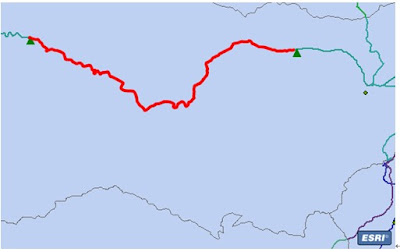
3、类似GoogleMap的交通流量地图:
首先看一下Google的交通流量地图:
可以看出,之所以能产生不同颜色段,需要的数据有3个:该段的起始和终止M值,该段的车流量。假设我们获取的业务数据表(EventTable)如下:
联想到上面第二个应用场景,我们便想可以获取所有交通数据后,用循环的办法展示出交通流量地图。但这里有两个问题需要思考:1、即使使用IRouteLocator2.LocateRow方法,服务器端根据起止M值解析出所有的分段图形需要一次循环,客户端将这些图形显示出来还需要一次循环,这样是否合理?2、由于结果显示在客户端,不同用户发出请求时,都将重复上面两个循环,如何改进?
解决问题一:在第二节的Linear Referencing实现原理中,提到了RouteEventSource类,可以将它看作是把Route FeatureClass和EventTable组合在一起的结果,而该类继承自FeatureClass,可当作一个FeatureClass来用。在ArcMap中观察生成后(利用Make Route Event Layer工具)的RouteEventSource层:
不仅包含了EventTable中的事件,还有了我们想要的Shape字段(可取出Geometry)。其实Shape字段中的内容,是利用Dynamic Segmentation技术动态计算出来的。看其图层属性便知,它是在内存中动态生成的:
有了FeatureClass,我们便可以对整个图层进行一次渲染,避免服务器端和客户端的两次循环了。这里要注意,FeatureClass是动态生成的,图层便是动态添加,在地图服务的REST接口中无法暴露出来,也就不能利用客户端API的渲染技术了。
解决问题二:利用SOA的思想,将交通流量图做成一个Traffic服务,不同用户请求时动态添加该服务即可。想想这个服务应该具有的特性:不同时段的交通图,需要动态生成;如果交通图已经生成,则无需重新生成,显示即可。所以我们采取池化方式服务(pooled-service)的特性,刚好解决这一问题。
这个场景我们用Web ADF来实现(客户端API与前两个场景相同)。
首先准备两个Map Service:底图服务:shaanxi,交通流量图服务:ShaanxiTraffic。
后者在ArcMap中打开是这样的: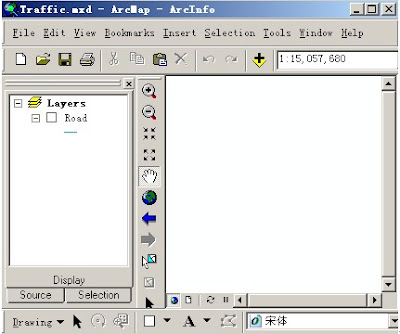
ShaanxiTraffic服务除了动态生成的交通流量图外,不需要在显示任何信息,所以发布时是空白的;因为动态生成的RouteEventSource将作为图层插入到这个地图服务中,所以Route FeatureClass必须也在这个mxd中才行。
Default.aspx页面中放置一个MapResourceManager控件、一个Map控件、一个CallbackButton按钮和一个GridView控件。先看一下结果:
点击按钮后:
看一下Default.aspx.cs中按钮的点击事件:protected void CallbackButton1_Clicked(object sender, EventArgs args)
{
//先判断Traffic服务中是否已经产生结果
if (hasTrafficResult())//Traffic服务中已经有结果
{
//将结果插入地图
InsertTrafficService();
}
else//服务中还没有结果
{
//先生成交通流量结果
MakeResult();
//将结果插入地图
InsertTrafficService();
}
//显示RouteEventSource的属性表
DisplayAttributeTable();
}
思路都在代码中。依次来看几个函数:///
///
///
private bool hasTrafficResult()
{
ESRI.ArcGIS.ADF.Identity identity = new ESRI.ArcGIS.ADF.Identity("ArcGISWebServices", "yourpassword", "");
ESRI.ArcGIS.ADF.Connection.AGS.AGSServerConnection agsconn = new ESRI.ArcGIS.ADF.Connection.AGS.AGSServerConnection("machinename", identity);
agsconn.Connect();
pSOM = agsconn.ServerObjectManager;
ESRI.ArcGIS.Server.IServerContext pServerContext = pSOM.CreateServerContext("ShaanxiTraffic", "MapServer");
ESRI.ArcGIS.Carto.IMapServer2 pMapServer = pServerContext.ServerObject as ESRI.ArcGIS.Carto.IMapServer2;
ESRI.ArcGIS.Carto.IMapServerObjects2 pMapServerObjects = pMapServer as ESRI.ArcGIS.Carto.IMapServerObjects2;
ESRI.ArcGIS.Carto.IMap pMap = pMapServerObjects.get_Map(pMapServer.DefaultMapName);
pServerContext.ReleaseContext();
return pMap.LayerCount == 1 ? false : true;
}
对于ShaanxiTraffic服务,在获得的Server Object中,查看当前Map的图层数(默认有一个隐藏的Road图层),若为1则还未产生结果。
下面是动态添加服务的函数,注意要设置背景透明,以便能够看到底图服务:///
///
private void InsertTrafficService()
{
if (MapResourceManager1.ResourceItems.Count==1)//若已插入交通流量服务,则不做动作
{
MapResourceItem mapResourceItem = new MapResourceItem();
GISResourceItemDefinition definition = new GISResourceItemDefinition();
mapResourceItem.Name = "Traffic";
definition.ResourceDefinition = "Layers@ShaanxiTraffic";
definition.DataSourceDefinition = "machinename";
definition.DataSourceType = "ArcGIS Server Local";
mapResourceItem.Parent = MapResourceManager1;
mapResourceItem.Definition = definition;
ESRI.ArcGIS.ADF.Web.DisplaySettings displaysettings = new ESRI.ArcGIS.ADF.Web.DisplaySettings();
displaysettings.Transparency = 0.0F;
displaysettings.Visible = true;
ESRI.ArcGIS.ADF.Web.ImageDescriptor imagedescriptor = new ESRI.ArcGIS.ADF.Web.ImageDescriptor();
imagedescriptor.TransparentBackground = true;
imagedescriptor.TransparentColor = System.Drawing.Color.White;
displaysettings.ImageDescriptor = imagedescriptor;
mapResourceItem.DisplaySettings = displaysettings;
MapResourceManager1.ResourceItems.Insert(0, mapResourceItem);
MapResourceManager1.CreateResource(mapResourceItem);
if (Map1.ImageBlendingMode == ImageBlendingMode.WebTier)
{
Map1.Refresh();
}
else
{
Map1.RefreshResource("Traffic");
}
CallbackButton1.CallbackResults.CopyFrom(Map1.CallbackResults);
}
}
MakeResult函数利用ESRI.ArcGIS.Location库来生成交通流量图。由于Traffic服务是池化服务,当第一个用户请求,生成交通流量图后,该实例(servercontext)会返回服务器上而不被销毁,所以下一个用户再次请求时可以直接显示。如果要实现实时的交通流量图,定时在服务器端重生servercontext,并读取当前时段的EventTable即可。///
///
private void MakeResult()
{
ESRI.ArcGIS.Server.IServerContext pServerContextTraffic = pSOM.CreateServerContext("ShaanxiTraffic", "MapServer");
ESRI.ArcGIS.Carto.IMapServer2 pMapServer = pServerContextTraffic.ServerObject as ESRI.ArcGIS.Carto.IMapServer2;
ESRI.ArcGIS.Carto.IMapServerObjects2 pMapServerObjects = pMapServer as ESRI.ArcGIS.Carto.IMapServerObjects2;
ESRI.ArcGIS.Carto.IMap pMap = pMapServerObjects.get_Map(pMapServer.DefaultMapName);
//创建RouteLocator
IFeatureClass pFC = (GetLayerByName("Road",pMap) as IFeatureLayer).FeatureClass;
IDataset dS = (IDataset)pFC; // A polylineM feature class.
IName name = dS.FullName;
IRouteLocatorName rtLocatorName = pServerContextTraffic.CreateObject("esriLocation.RouteMeasureLocatorName") as IRouteLocatorName;
rtLocatorName.RouteFeatureClassName = name;
rtLocatorName.RouteIDFieldName = "道路编码";
rtLocatorName.RouteMeasureUnit = esriUnits.esriUnknownUnits;
name = (IName)rtLocatorName;
IRouteLocator2 pRtLocator = (IRouteLocator2)name.Open();
//创建RouteEventProperties,为RouteEventSource做准备
IRouteEventProperties2 rtProp = pServerContextTraffic.CreateObject("esriLocation.RouteMeasureLineProperties") as IRouteEventProperties2;
rtProp.AddErrorField = true;
rtProp.ErrorFieldName = "LOC_ERROR";
rtProp.EventMeasureUnit = esriUnits.esriUnknownUnits;
rtProp.EventRouteIDFieldName = "RouteID";
IRouteMeasureLineProperties rMLineProp = (IRouteMeasureLineProperties)rtProp;
rMLineProp.FromMeasureFieldName = "FromM";
rMLineProp.ToMeasureFieldName = "ToM";
//创建RouteEventSource
ITable eventTable = (pFC.FeatureDataset.Workspace as IFeatureWorkspace).OpenTable("lineEventsTable");
IDataset ds = (IDataset)eventTable;
IName name2 = ds.FullName;
IRouteEventSourceName rtEvtSrcName = pServerContextTraffic.CreateObject("esriLocation.RouteEventSourceName") as IRouteEventSourceName;
rtEvtSrcName.EventTableName = name2;
rtEvtSrcName.EventProperties = (IRouteEventProperties)rMLineProp;
rtEvtSrcName.RouteLocatorName = rtLocatorName;
name2 = (IName)rtEvtSrcName;
IRouteEventSource rtEvtSrc = (IRouteEventSource)name2.Open();
//转换到FeatureClass
pFC = rtEvtSrc as IFeatureClass;
//将RouteEventSource添加到地图中,并进行唯一值渲染
IUniqueValueRenderer pUVR = pServerContextTraffic.CreateObject("esriCarto.UniqueValueRenderer") as IUniqueValueRenderer;
pUVR.FieldCount = 1;
pUVR.set_Field(0, "Vehicles");
pUVR.UseDefaultSymbol = false;
IFeatureCursor pFeatureCursor = pFC.Search(null, false);
IFeature pFeature = pFeatureCursor.NextFeature();
int ifiledindex = pFC.Fields.FindField("Vehicles");//EventTable中的车流量字段
while (pFeature != null)
{
ISimpleLineSymbol pSymbol = pServerContextTraffic.CreateObject("esriDisplay.SimpleLineSymbol") as ISimpleLineSymbol;
double value = double.Parse(pFeature.get_Value(ifiledindex).ToString());
if (value <= 20)
pSymbol.Color = ESRI.ArcGIS.ADF.Converter.ToRGBColor(pServerContextTraffic, System.Drawing.Color.FromArgb(71, 196, 69)) as IColor;
else if (value > 20 && value <= 50)
pSymbol.Color = ESRI.ArcGIS.ADF.Converter.ToRGBColor(pServerContextTraffic, System.Drawing.Color.FromArgb(255, 255, 0)) as IColor;
else if (value > 50 && value <= 100)
pSymbol.Color = ESRI.ArcGIS.ADF.Converter.ToRGBColor(pServerContextTraffic, System.Drawing.Color.FromArgb(201, 59, 46)) as IColor;
else
pSymbol.Color = ESRI.ArcGIS.ADF.Converter.ToRGBColor(pServerContextTraffic, System.Drawing.Color.FromArgb(250, 52, 17)) as IColor;
pSymbol.Width = 5;
pUVR.AddValue(pFeature.get_Value(ifiledindex).ToString(), "Vehicles", pSymbol as ISymbol);
pFeature = pFeatureCursor.NextFeature();
}
IFeatureLayer pFL = pServerContextTraffic.CreateObject("esriCarto.FeatureLayer") as IFeatureLayer;
pFL.Name = "RouteEventSource";
pFL.FeatureClass = pFC;
(pFL as IGeoFeatureLayer).Renderer = pUVR as IFeatureRenderer;
pMap.AddLayer(pFL as ILayer);//to the 0 index
pMapServerObjects.RefreshServerObjects();
pServerContextTraffic.ReleaseContext();
}
一点注意,在使用IServerContext接口时要及时进行释放。
思考一下:如何通过Geoprocessing Service来实现“交通流量图”?
